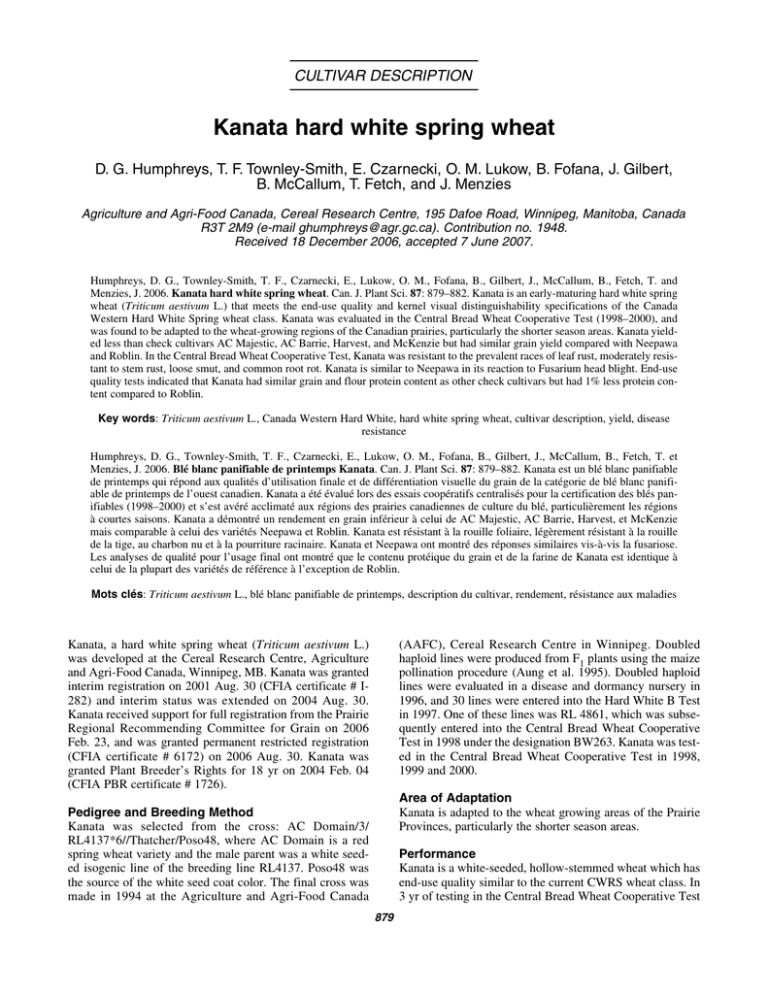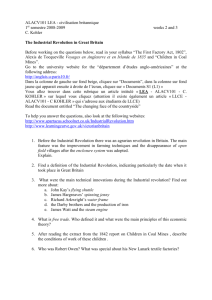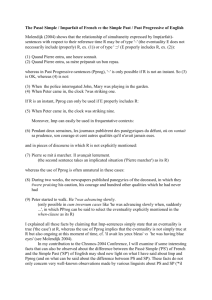Kanata - Prairie Grain Development Committee (PGDC)
advertisement

CULTIVAR DESCRIPTION Kanata hard white spring wheat D. G. Humphreys, T. F. Townley-Smith, E. Czarnecki, O. M. Lukow, B. Fofana, J. Gilbert, B. McCallum, T. Fetch, and J. Menzies Agriculture and Agri-Food Canada, Cereal Research Centre, 195 Dafoe Road, Winnipeg, Manitoba, Canada R3T 2M9 (e-mail ghumphreys@agr.gc.ca). Contribution no. 1948. Received 18 December 2006, accepted 7 June 2007. Humphreys, D. G., Townley-Smith, T. F., Czarnecki, E., Lukow, O. M., Fofana, B., Gilbert, J., McCallum, B., Fetch, T. and Menzies, J. 2006. Kanata hard white spring wheat. Can. J. Plant Sci. 87: 879–882. Kanata is an early-maturing hard white spring wheat (Triticum aestivum L.) that meets the end-use quality and kernel visual distinguishability specifications of the Canada Western Hard White Spring wheat class. Kanata was evaluated in the Central Bread Wheat Cooperative Test (1998–2000), and was found to be adapted to the wheat-growing regions of the Canadian prairies, particularly the shorter season areas. Kanata yielded less than check cultivars AC Majestic, AC Barrie, Harvest, and McKenzie but had similar grain yield compared with Neepawa and Roblin. In the Central Bread Wheat Cooperative Test, Kanata was resistant to the prevalent races of leaf rust, moderately resistant to stem rust, loose smut, and common root rot. Kanata is similar to Neepawa in its reaction to Fusarium head blight. End-use quality tests indicated that Kanata had similar grain and flour protein content as other check cultivars but had 1% less protein content compared to Roblin. Key words: Triticum aestivum L., Canada Western Hard White, hard white spring wheat, cultivar description, yield, disease resistance Humphreys, D. G., Townley-Smith, T. F., Czarnecki, E., Lukow, O. M., Fofana, B., Gilbert, J., McCallum, B., Fetch, T. et Menzies, J. 2006. Blé blanc panifiable de printemps Kanata. Can. J. Plant Sci. 87: 879–882. Kanata est un blé blanc panifiable de printemps qui répond aux qualités d’utilisation finale et de différentiation visuelle du grain de la catégorie de blé blanc panifiable de printemps de l’ouest canadien. Kanata a été évalué lors des essais coopératifs centralisés pour la certification des blés panifiables (1998–2000) et s’est avéré acclimaté aux régions des prairies canadiennes de culture du blé, particulièrement les régions à courtes saisons. Kanata a démontré un rendement en grain inférieur à celui de AC Majestic, AC Barrie, Harvest, et McKenzie mais comparable à celui des variétés Neepawa et Roblin. Kanata est résistant à la rouille foliaire, légèrement résistant à la rouille de la tige, au charbon nu et à la pourriture racinaire. Kanata et Neepawa ont montré des réponses similaires vis-à-vis la fusariose. Les analyses de qualité pour l’usage final ont montré que le contenu protéique du grain et de la farine de Kanata est identique à celui de la plupart des variétés de référence à l’exception de Roblin. Mots clés: Triticum aestivum L., blé blanc panifiable de printemps, description du cultivar, rendement, résistance aux maladies Kanata, a hard white spring wheat (Triticum aestivum L.) was developed at the Cereal Research Centre, Agriculture and Agri-Food Canada, Winnipeg, MB. Kanata was granted interim registration on 2001 Aug. 30 (CFIA certificate # I282) and interim status was extended on 2004 Aug. 30. Kanata received support for full registration from the Prairie Regional Recommending Committee for Grain on 2006 Feb. 23, and was granted permanent restricted registration (CFIA certificate # 6172) on 2006 Aug. 30. Kanata was granted Plant Breeder’s Rights for 18 yr on 2004 Feb. 04 (CFIA PBR certificate # 1726). (AAFC), Cereal Research Centre in Winnipeg. Doubled haploid lines were produced from F1 plants using the maize pollination procedure (Aung et al. 1995). Doubled haploid lines were evaluated in a disease and dormancy nursery in 1996, and 30 lines were entered into the Hard White B Test in 1997. One of these lines was RL 4861, which was subsequently entered into the Central Bread Wheat Cooperative Test in 1998 under the designation BW263. Kanata was tested in the Central Bread Wheat Cooperative Test in 1998, 1999 and 2000. Area of Adaptation Kanata is adapted to the wheat growing areas of the Prairie Provinces, particularly the shorter season areas. Pedigree and Breeding Method Kanata was selected from the cross: AC Domain/3/ RL4137*6//Thatcher/Poso48, where AC Domain is a red spring wheat variety and the male parent was a white seeded isogenic line of the breeding line RL4137. Poso48 was the source of the white seed coat color. The final cross was made in 1994 at the Agriculture and Agri-Food Canada Performance Kanata is a white-seeded, hollow-stemmed wheat which has end-use quality similar to the current CWRS wheat class. In 3 yr of testing in the Central Bread Wheat Cooperative Test 879 880 CANADIAN JOURNAL OF PLANT SCIENCE Table 1. Agronomic data for Kanata and check cultivars based on data collected in the Central Bread Wheat Cooperative Test (1998–2000) Yield (kg ha–1) Cultivar Maturity (d) Zone 1z Zone 2y Mean Lodgingx Zone 1 Zone 2 Mean Height (cm) (1–9 scale) Falling number (s) Test weight (kg hL–1) Kernel weight (mg) Field Artificial Sproutingw score (1–9 scale) Neepawa Roblin AC Majestic McKenzie Harvest AC Barrie 3430 3540 3820 4560 4340 3900 3700 3590 3950 4380 4070 3970 3570 3560 3890 4470 4200 3940 90.5 89.6 91.4 91.8 90.3 91.7 98.7 96.8 101.7 98.4 99.2 100.3 95.1 93.6 97.1 95.5 95.3 96.5 104 97 98 98 94 100 3.2 2.2 2.4 3.1 1.7 2.5 76.7 75.9 77.5 78.9 78.9 78.6 29.8 32.2 31.2 31.6 32.2 32.4 312 169 432 382 404 266 240 152 367 376 434 295 4.9 8.2 1.7 2.4 1.5 4.2 Kanata 3560 3580 3570 89.7 98.9 94.8 94 1.9 78.5 30.5 284 315 4.1 202 14 141 15 127 29 0.7 11 1.1 14 0.7 25 1 27 0.4 21 0.4 30 0.9 30 96 3 81 3 1.2 3 LSD (P < 0.05)v Station years zZone 1 includes: Glenlea, Portage la Prairie, Morden, Brandon, and Elgin in Manitoba (Brandon 2000 not included). yZone 2 includes: Indian Head, Regina, Kernen, Kelvington, and Melfort in Saskatchewan. xLodging scale: 1 = vertical; 9 = flat. wSprouting score: 1= resistant; 9 = susceptible. vLSD of means was based on the checks including Kanata and calculated using the SAS proc mixed procedure. (1998–2000), grain yield of Kanata was comparable to that of Neepawa and Roblin, but 8.2% less than AC Majestic, 9.4% less than AC Barrie, and 20.1% less than McKenzie (Table 1). Kanata has maturity similar to Neepawa, McKenzie, and Harvest. It matured 1 d later than Roblin and 1 d earlier than AC Barrie and 2 d earlier than AC Majestic (Table 1). Kanata had plant height similar to Harvest but was 3–10 cm shorter than the other check cultivars. Kanata had similar lodging scores to Harvest, and was lower than the other check cultivars (Table 1). Other Characteristics SPIKE: Tapering, erect, glaucosity weak, white at maturity, short awns or awnlets present. GLUMES: Midwide, midlong, glabrous, shoulders slightly sloping and midwide, beak short and slightly curved. KERNEL: Hard, white kernel, midsize to small, midwide, oval kernel with rounded cheeks, midsize brush hairs, midsize and oval shaped embryo, midwide and middeep crease. DISEASE REACTION: As part of the cooperative testing, leaf rust (caused by Puccinia triticina Eriks.) and stem rust (caused by Puccinia graminis Pers. f. sp. tritici Eriks. E. Henn.) reactions were evaluated in an epiphytotic nursery. Kanata was moderately resistant to the prevalent races of leaf rust, and moderately resistant to stem rust, loose smut [caused by Ustilago tritici (Pers.) Rostr.], and common root rot. Kanata was susceptible to common bunt [caused by Tilletia laevis Fuhn in Rabenh and T. tilletia (Bjerk.) R. Wolf] and was similar to the checks in its reaction to tan spot [caused by Pyrenophora tritici-repentis (Died.) Drechs.]. Kanata displayed similar disease response to Fusarium head blight as AC Majestic, Mckenzie and AC Barrie (Table 2). The leaf rust races used were those multiplied from collections made the previous year (Kolmer 1999, 2001; McCallum and Seto-Goh 2002). The stem rust races included: TPMKR, TMRTK, RKQSR, QFCSH, RTHJT, and QTHST (Fetch 2003). The races of loose smut included: T2, T9, T10, and T39 (Menzies et al. 2003) and the races of common bunt included: L7, L16, T1, T6, T13, and T19 (Gaudet and Puchalski 1989a, b). Race designations are described by Roelfs and Martens (1988) for stem rust, Neilsen (1987) for loose smut, and Hoffman and Metzger (1976) for common bunt. END-USE SUITABILITY. Kanata is eligible for all grades of the Canada Western Hard White Spring wheat class (Table 3), exhibiting on average 1% less grain and flour protein compared to Roblin but similar to other check cultivars. Kanata had a higher falling number than Neepawa, Roblin, McKenzie, and AC Barrie but was lower than other check cultivars. Kanata had higher starch gelatinization properties than Neepawa, Roblin, McKenzie, and AC Barrie but was lower than AC Majestic and Harvest, as indicated by the amylograph (Table 3). Maintenance and Distribution of Pedigreed Seed The breeder lines were derived from heads taken at random from a third generation (DH3) increase plot. These heads were grown in isolation as rows at Glenlea, MB in 1998 and as breeder plots at Lincoln, New Zealand 1999–2000. Kanata breeder seed was generated from a bulk of 103 breeder’s lines. Breeder seed is maintained by the AAFC Seed Increase Unit, Indian Head, SK. Distribution and multiplication of pedigree seed stocks is the responsibility of FarmPure Seeds Ltd., 418B Macdonald St., Regina, Saskatchewan, Canada S4N 6E1. We gratefully acknowledge K. R. Preston (Grain Research Laboratory, Canadian Grain Commission, Winnipeg, MB) for enduse quality assessment; D. A. Gaudet and B. J. Puchalski (AAFC, Lethbridge Research Centre, Lethbridge, AB) for providing reaction to common bunt; M. Fernandez (AAFC, Semi-Arid Prairie 15 MRMS 30 MRMS tr R tr R 0R 0R 0R 0R 2000 1998 tr R 50 MR-S 5M 30 MRMS tr R 30 MRMS 10 RMR 60 MS 10 MR 40 MR tr R 40 MRMS 1999 Leaf rusty 5 MR 50 S 40 MS 15 MRMS tr R 20 MRMS 2000 29 11 20 15 9 21 1998 67 57 44 68 53 83 1999 Root rot - - 2000 1998 23 I 39 S 8R 3R 16 IR 35 S 17 MRa 45 MR 61 MR 0R 0 Ra 3R 0 Ra 0 Ra 0 Ra 9R 23 MR 38 I 3R 0R 18 MR 43 MS 33 MR 3R 1999 34 S 29 MS 39 S+ 8 MR 2R 25 MS 1999 38 S 22 I 44 S 10 R 52 S 2 VR 2000 Common buntw 2000 1998 Loose smutx 34 MS 40 MS 70 S 34 MS 39 MS 29 I 1998 25 I 10 MR 62 S 13 MR 18 MR 13 MR 1999 23 I 20 MR 42 S 24 I 30 I 22 I 2000 Fusarium head blight indexv 9.7 10.3 10.0 10.0 10.0 10.0 Neepawa Robin AC Majestic McKenzie AC Barrie Kanata 5.0 5.0 5.0 5.0 5.0 5.0 1999 Tan Spotu – – – – – – 2000 1998 10.3 –1.4 0.3 –4.9 –1.3 0.2 = S. 13.3 21.5 6.5 13.1 10.2 7.7 1999 Septoria nodorum MKW reduction uCaused by Pyrenophora tritici-repentis (Died.) Drechs. sMcFadden’s scale <5 = R; 6 = MR; 7 = I; 8–9 = MS; 10–11 1998 Cultivar Table 2. Continued 6.8 11.5 15.7 12.4 8.9 1.4 2000 10.3 10.0 10.0 10.0 9.7 9.7 1998 10.0 9.8 9.8 9.3 9.5 9.5 1999 8.7 9.0 8.7 8.3 9.0 8.0 2000 Septoria nodorum score 1998 1.07 –6.38 –5.54 –10.53 –5.97 –2.53 – – – – – – 1999 Septoria tritici MKW reduction 6.7 11.4 16.7 10.0 8.8 2.3 2000 10.0 10.3 10.3 10.0 9.3 10.3 1998 2.0 2.0 2.0 2.0 2.0 1.0 1999 11.0 11.0 11.0 11.0 11.0 11.0 2000 Septoria tritici scores by Puccinia graminis Pers. f. sp. tritici Eriks. E. Henn. Races used include TPMKR, TMRTK, RKQSR, QFCSH, RTHJT, and QTHST (Roelfs and Martens 1988; Fetch 2003); rating is % severity and infection type, respectively. yCaused by Puccinia triticina Eriks. Inoculum was a composite of all leaf rust races multiplied from collections made the previous year (Kolmer 1999, 2001; McCallum and Seto-Goh 2002); rating is percent severity and infection type, respectively. xCaused by Ustilago tritici (Pers.) Rostr. Races include T2, T9, T10, and T39 (Nielsen 1987; Menzies et al. 2003); rating is % infection. wCaused by Tilletia laevis Kuhn in Rabenh and T. tritici (Bjerk.) R. Wolf. The inoculum used was a composite of races T1, T6, T13, and T19 of T. tritici and L1, L16 of T. laevis mixed (vol/vol) in a 1:1:1:1:2:2 ratio (Gaudet and Puchalski 1989a) and represents the virulence spectrum of bunt isolates in western Canada (Gaudet and Puchalski 1989b); rating is percent infection. vFusarium head blight index is equal to (% incidence × % severity)/100. zCaused Kanata 3R 1R 1R 5R 5R Neepawa Robin AC Majestic McKenzie AC Barrie 1999 5 RMR tr R tr R tr R 5R 1998 Cultivar Stem rustz Table 2. Disease reactions for Kanata and check cultivars from the Central Bread Wheat Cooperative Test, 1998–2000 HUMPHREYS ET AL. — KANATA HWSW 881 882 CANADIAN JOURNAL OF PLANT SCIENCE Table 3. Wheat and flour analytical data for Kanata and check cultivars based on end-use testingz from the Central Bread Wheat Cooperative Test (1998–2000) Cultivar Test Kernel Grain weight weight protein –1 –1 (kg hL ) (mg kernel ) (%) Flour protein (%) Protein loss Falling Amylonumber graph (s) (BU) Flour yield (%) Flour ash (%) KJ colory (A) Agtron Starch Particle color damage size index (%) (%) (%) Neepawa Roblin AC Majestic McKenzie Harvest AC Barrie 80.3 79.8 80.9 81.9 81.5 81.9 32.1 34.8 33.3 33.6 34.6 34.7 14.5 15.3 14.7 14.4 14.2 14.3 13.7 14.6 14.0 13.7 13.5 13.5 0.8 0.7 0.7 0.7 0.7 0.7 395 338 432 395 447 400 608 428 1042 692 837 698 74.3 74.5 75.6 75.8 75.8 76.2 0.46 0.44 0.44 0.45 0.47 0.44 –2.3 –2.0 –2.2 –2.2 –1.9 –2.3 77 75 75 76 73 78 6.3 5.2 6.3 7.1 7.1 6.2 55 58 53 51 51 55 Kanata 81.2 31.8 14.7 13.9 0.8 417 813 76.4 0.45 –2.0 76 6.7 51 0.7 3 1.1 3 0.2 3 0.2 3 – 2 2 3 0.3 3 1 3 LSD (P < 0.05) Station years – 3 41.7 3 149.8 3 0.5 3 – 3 Table 3. Continued Farinograph Cultivar Neepawa Roblin AC Majestic McKenzie Harvest AC Barrie Kanata LSD (P < 0.05) Station years Absorption (%) Dough development time (min) Mixing tolerance index (BU) Canadian Short Process (150 ppm Ascorbic Acid) Stability index (min) Loaf volume Loaf (cm3) appearance Crumb structure Crumb color 65.9 66.4 66.9 67.4 68.0 63.8 65.6 4.42 7.58 5.08 5.08 5.33 5.67 5.50 33 22 37 37 33 37 28 6.50 17.00 6.33 7.00 7.33 9.33 9.33 1147 1150 1115 1072 1073 1115 1067 8.0 7.7 7.8 7.7 7.6 7.7 7.4 5.9 6.2 6.1 6.1 6.1 6.2 6.2 7.9 8.0 8.2 8.1 8.1 8.0 8.0 0.9 3 0.58 3 5 3 2.59 3 26 3 0.2 3 3 3 Mixing Mixing Absorption energy time –1 (%) (W h kg ) (min) 69 71 70 71 71 68 70 10.1 15.5 13.2 11.8 12.1 13.1 15.9 7.4 12.6 9.7 9.3 9.3 10.2 12.6 1 3 2.3 3 1.2 3 z American Association of Cereal Chemist methods were followed by the Grain Research Laboratory, Canadian Grain Commission for evaluating the various end-use suitability traits on a composite of grain generated each year (1998–2000) from the Central Bread Wheat Cooperative test. yKJ Color data were not collected in 2000. Research Centre, Swift Current, SK) for providing reaction to root rot; and D. T. Gehl (AAFC, Seed Increase Unit, Indian Head, SK) for multiplication of Breeder seed. Aung, T., Howes, N. K., McKenzie, R. I. H. and TownleySmith, T. F. 1995. Application of the maize pollen method for wheat double haploid (DH) generation in western Canadian spring wheat breeding programs. Annual Wheat Newsl. 41: 70. Fetch, T. G., Jr. 2003. Physiological specialization of Puccinia graminis on wheat, barley, and oat in 2000. Can. J. Plant Pathol. 25: 174–181. Gaudet, D. A. and Puchalski, B. L. 1989a. Status of bunt resistance in western Canadian spring wheat and triticale. Can. J. Plant Sci. 69: 797–804. Gaudet, D. A. and Puchalski, B. L. 1989b. Races of common bunt (Tilletia caries and T. foetida) in western Canada. Can. J. Plant Pathol. 11: 415–418. Hoffmann, J. A. and Metzger, R. J. 1976. Current status of virulence genes and pathogenic races of the wheat bunt fungi in the northwestern USA. Phytopathology 66: 657–660. Kolmer, J. A. 1999. Physiologic specialization of Puccinia triticina in Canada in 1997. Plant Dis. 83:194–197. Kolmer, J. A. 2001. Physiologic specialization of Puccinia triticina in Canada in 1998. Plant Disease 85: 155–158. McCallum, B. D. and Seto-Goh, P. 2002. Physiologic specialization of wheat leaf rust (Puccinia triticina) in Canada in 1999. Can. J. Plant Pathol. 24: 205–210. Menzies, J. G., Knox, R. E., Nielsen, J. and Thomas, P. L. 2003. Virulence of Canadian isolates of Ustilago tritici; 1964–1998, and the use of the geometric rule in understanding host differential complexity. Can. J. Plant Pathol. 25: 62–72. Nielsen, J. 1987. Races of Ustilago tritici and techniques for their study. Can. J. Plant Pathol. 9: 91–105. Roelfs, A. P. and Martens, J. W. 1988. An international system of nomenclature for Puccinia recondita f.sp. tritici and Puccinia graminis f.sp. tritici. Phytopathology 78: 525–533.

